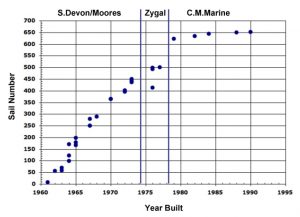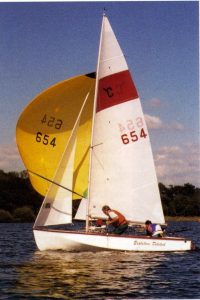Introduction – Seafly Builders
In contrast to some other dinghy classes established in the early 1960’s, the design copyright holders, South Devon Boatbuilders, tightly controlled the licence to build the Seafly. The only other builders licensed by them were Moores of Wroxham, Leslie Hanna in Northern Ireland, and two builders in Australia (Harold Lang and Brian Lay). Thus, while Seafly numbers grew steadily during the 1960’s (see graph) the class remained relatively small compared to more widely promoted designs. Only about 450 boats had been built by the time of the 1973 oil crisis. That event triggered an economic recession which brought an end to the 1960’s dinghy sailing boom.
By 1974, when South Devon Boatbuilders ceased trading, some Seaflys were being produced in GRP. The Seafly design rights were sold to Zygal Boats of Whitstable in Kent, who only built all GRP boats; only amateur builds of wooden boats were allowed. By 1976 Capital Industries were also building GRP boats in Australia.
Although Zygal Boats held the licence until the late 1970’s the number of Seaflys built by them is not clear. Sail numbers increased from around 500 to over 600 during the time Zygal held the rights but it seems likely that many of these sail numbers were reserved for boats which were not built.
At the end of the 1970’s the Seafly moulds and licence were obtained by a Seafly sailor from Highcliffe Sailing Club, Colin May. For a few years there appears to have been renewed construction activity with May’s firm, C.M.Marine, Dorset Dinghies and Bob Hoare (all in the Christchurch area) building racing Seaflys in GRP composite and/or wood. However from the mid 1980’s onward very few boats were built. For example, C622 was constructed in 1979, C643 in 1984, C652 in 1990, and C654 (pictured), probably the last Seafly registered by the original Class Association, built in 1993.
In the 21st century new Seaflys have been built. Longtime Seafly sailor Tony Longworth with Pete Lawson based at Ullswater in the English Lake District built at least three new boats (using sail numbers 2000+) and a new Seafly competed in the 2009 Lord Birkett Memorial Trophy race. When poor health forced Tony Longworth to retire, the demonstration dinghy and moulds were sold to John Claridge Boats. A highly respected designer and boat builder, John Claridge started to race the Seafly at the Royal Lymington Yacht Club with considerable success in the Club’s Handicap Dinghy Series. Drawing on his experience he redesigned the deck layout to produce a new Seafly with a self draining cockpit – the Seafly SD – which was first shown at the 2014 Southampton Boat Show. In 2016 three of the new dinghies were raced at Blakeney S.C. in a revived “Seafly National Championships”.
[Next: South Devon BoatBuilders]


